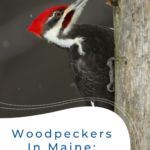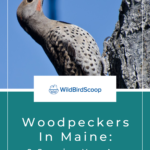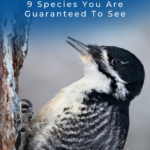Over the past decade or so, multiple species of woodpeckers have migrated to Maine in large numbers, especially during the summer breeding season. Mainers welcome woodpeckers to their state as many adore their bright colors, bold markings, and vibrant personalities!
In this article, we’ll talk about the different types of woodpeckers in Maine. Let’s dive right in.
Pileated Woodpecker
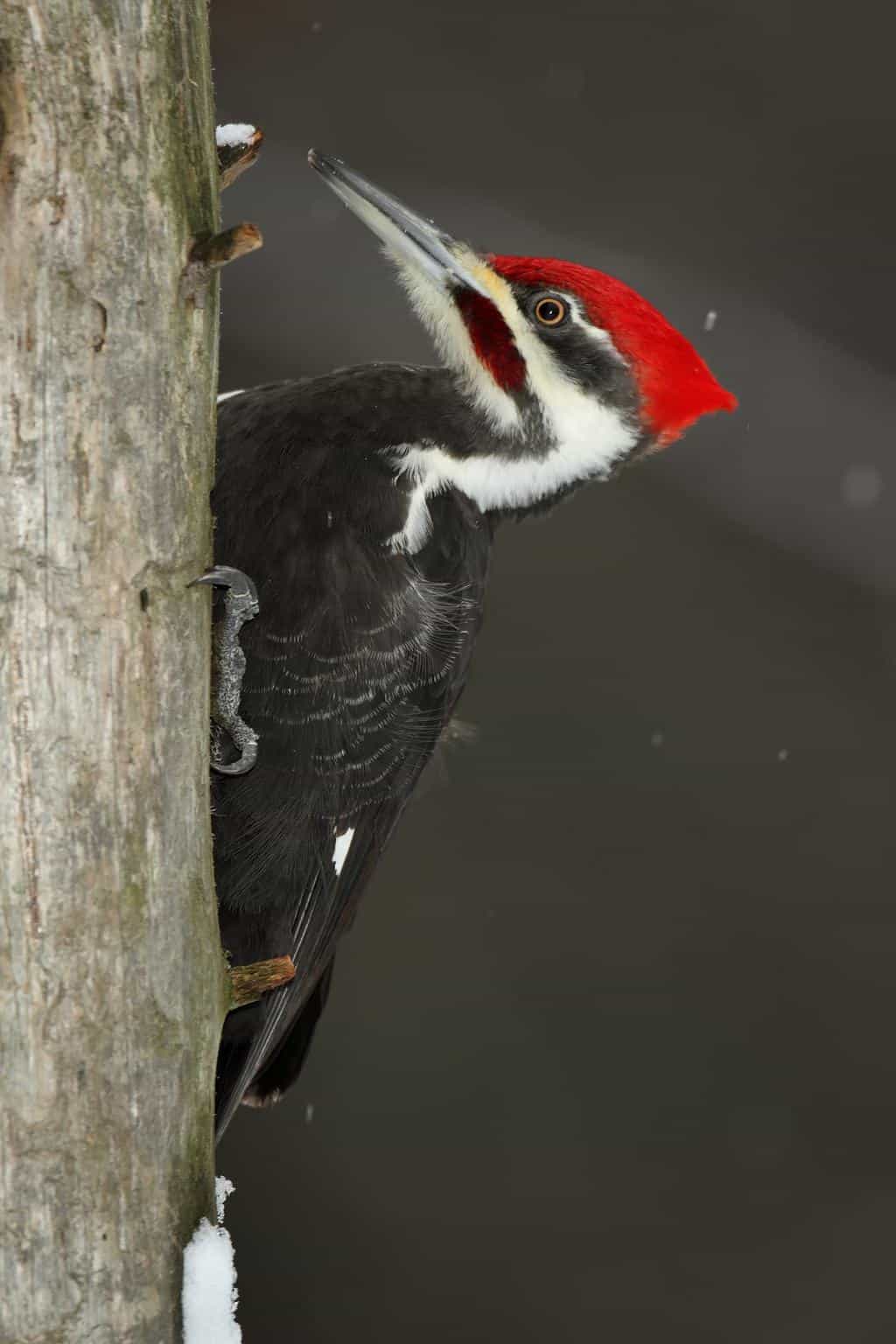
- Scientific Name: Dryocopus pileatus
- Length: 40 to 49 cm
- Weight: 9 to 14 oz
- Wingspan:2 cm
Pileated Woodpeckers are one of the biggest and most striking forest birds found in Maine.
These birds are identified by their black and white stripes, flaming-red crest, long neck, and triangular crest that sweeps off the back of their heads. Males have a red stripe on their cheeks, whereas females have none.
You’ll often find these birds drilling rectangular-shaped holes in rotten wood, mostly to dig up carpenter ants and other similar wood-dwelling insects. These excavations can be so broad and deep that they can cause small trees to break in half!
If you own dead or dying trees or snaps on your property and want to attract a few of these birds, consider leaving them alone. Doing so may tempt several Pileated Woodpeckers to come and visit you.
Yellow-Bellied Sapsucker
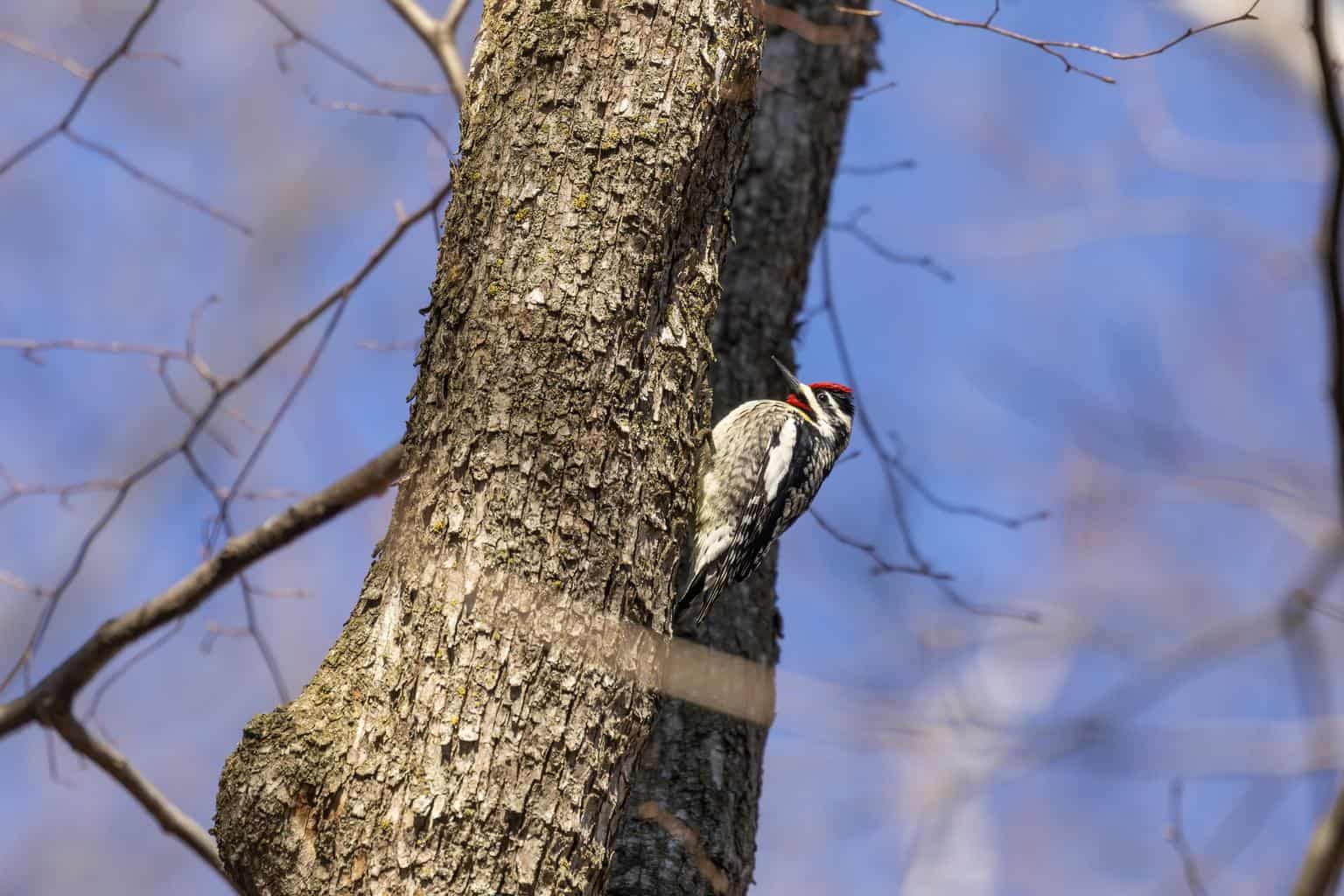
- Scientific Name: Sphyrapicus varius
- Length: 19 to 21 cm
- Weight: 5 oz
- Wingspan: 34 to 40 cm
Yellow-bellied sapsuckers are a relatively small species of woodpeckers with stout, straight bills. They’re mostly black and white with patterned faces and bright red foreheads. Male yellow-bellied sapsuckers have red throats, while female sapsuckers come without.
These woodpeckers lap up leaking sugary sap and trapped insects from tree trunks with their brush-tipped tongue. Compared to other woodpeckers, they can spend hours sitting still on tree trunks while feeding.
When it comes to habitat, you’ll often find yellow-bellied sapsuckers living in hardwood and conifer forests up to 6,500 feet in elevation. They nest in groves of small trees like aspens and spend most of their winters in open woodlands.
Unlike other woodpeckers on this list, these sapsuckers aren’t regular bird feeder visitors. So, if you’re looking to attract them, hang a few suet feeders. With your luck, they may decide to visit!
Downy Woodpecker

- Scientific Name: Picoides pubescens
- Length: 14 to 17 cm
- Weight: 7 to 1 oz
- Wingspan: 25 to 31 cm
Downy woodpeckers are the smallest species of woodpeckers in Maine and North America overall. They’re slightly larger than robins but no bigger than sparrows.
Mostly black and white, these woodpeckers have straight, chisel-like bills, blocky heads, and wide shoulders. Compared to other woodpeckers, their bills are quite small in size. Males have a small red patch on the back of the head, whereas females, again, have none.
Because they’re so small, they move more acrobatically than larger woodpeckers. They hitch around tree limbs, trunks, or drop into tall weeds to feed on galls.
During spring and summer, Mainers who live close to open woodlands will hear their shrill whinnying call drumming on trees. For such a small bird, they sure make a lot of noise!
Other than wooded areas, you can also find these gorgeous birds in orchards, city parks, backyards, and vacant lots. If you have a backyard feeder, there’s a high chance that they’ll drop by and say hello!
Hairy Woodpecker

- Scientific Name: Leuconotopicus villosus
- Length: 14 to 17 cm
- Weight:7 to 1 oz
- Wingspan: 36 to 38 cm
Many consider hairy woodpeckers as the older brothers of downy woodpeckers, primarily because of how similar they look! The only difference between them is the size; hairy woodpeckers are slightly bigger than the latter.
Hairy woodpeckers have an intense, almost soldier-like look with their erect, straight blacks, and cleanly stripped heads. You’ll find them foraging along with trucks, branches of large trees, and fallen logs.
They’re also found in woodlots, suburbs, and parks, as well as open woodlands of oak and pine.
To bring hairy woodpeckers into your yard, consider setting up a suet and bird feeders filled with black sunflower seeds and peanuts. For best results, do this during winter when food is scarce. If you have dead trees in your yard or dead parts of a living tree, a pair of hairy woodpeckers may start their family inside!
Red-Headed Woodpecker
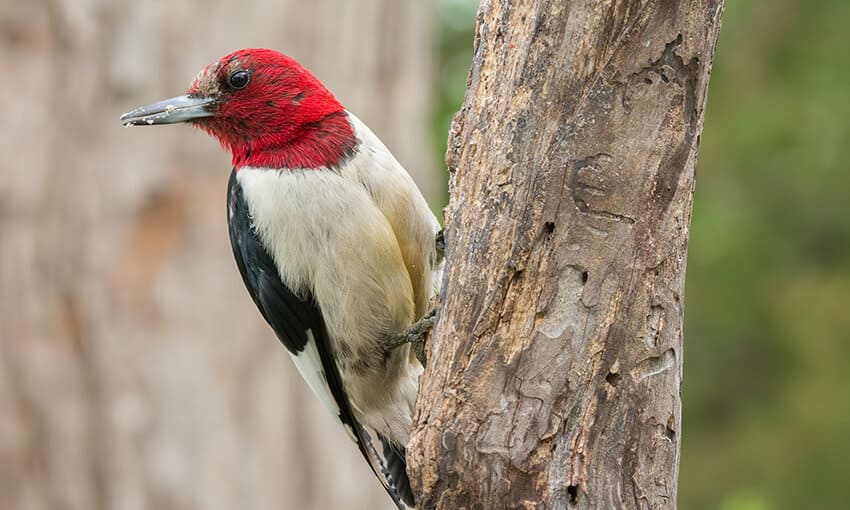
- Scientific Name: Melanerpes erythrocephalus
- Length: 21 to 25 cm
- Weight:5 oz
- Wingspan: 33 to 37 cm
Red-headed woodpeckers are so boldly patterned that bird enthusiasts often call them “flying checkerboards.” Their heads are entirely crimson in color, their bellies white as snow, and their wings a mixture of black and white. Both males and females look alike.
Similar to hairy woodpeckers, these bids are medium in size. You’ll often catch them in pine savannahs and other open forests with clear understories.
Alongside eating insects from tree trunks like normal woodpeckers, red-headed woodpeckers also catch insects while in flight and hunt them on the ground. They also eat a considerable amount of fruit and seeds like acorns and beechnuts.
To attract these beautiful birds, all you’ll need to do is to add a feeder or suet in your backyard during winter. They eat anything from apples, pears, and many different kinds of seeds.
Red-Bellied Woodpecker

- Scientific Name: Melanerpes carolinus
- Length: 23 to 27 cm
- Weight: 5 oz
- Wingspan: 38 to 46 cm
Red-bellied woodpeckers are arguably one of the most beautiful birds alive. Their black-and-white striped back and gleaming red cap and nape make them a sight to behold.
Many Mainers confuse the red-bellied woodpecker with the red-headed woodpecker. It’s an honest mistake; after all, not all red-bellied woodpeckers have red bellies!
If you live near any wooded patches, you may attract these striking birds using feeders with suet during winter. These birds like eating peanuts and sunflower seeds. You can also spot them drinking nectar from hummingbird feeders.
Red-bellied woodpeckers are commonly found in old stands of oak and hickory and/or young hardwoods and pines. Rather than drilling into the surfaces of bark trees, you’ll find them picking at it with their long, 2-inch tongues.
Black-Backed Woodpecker
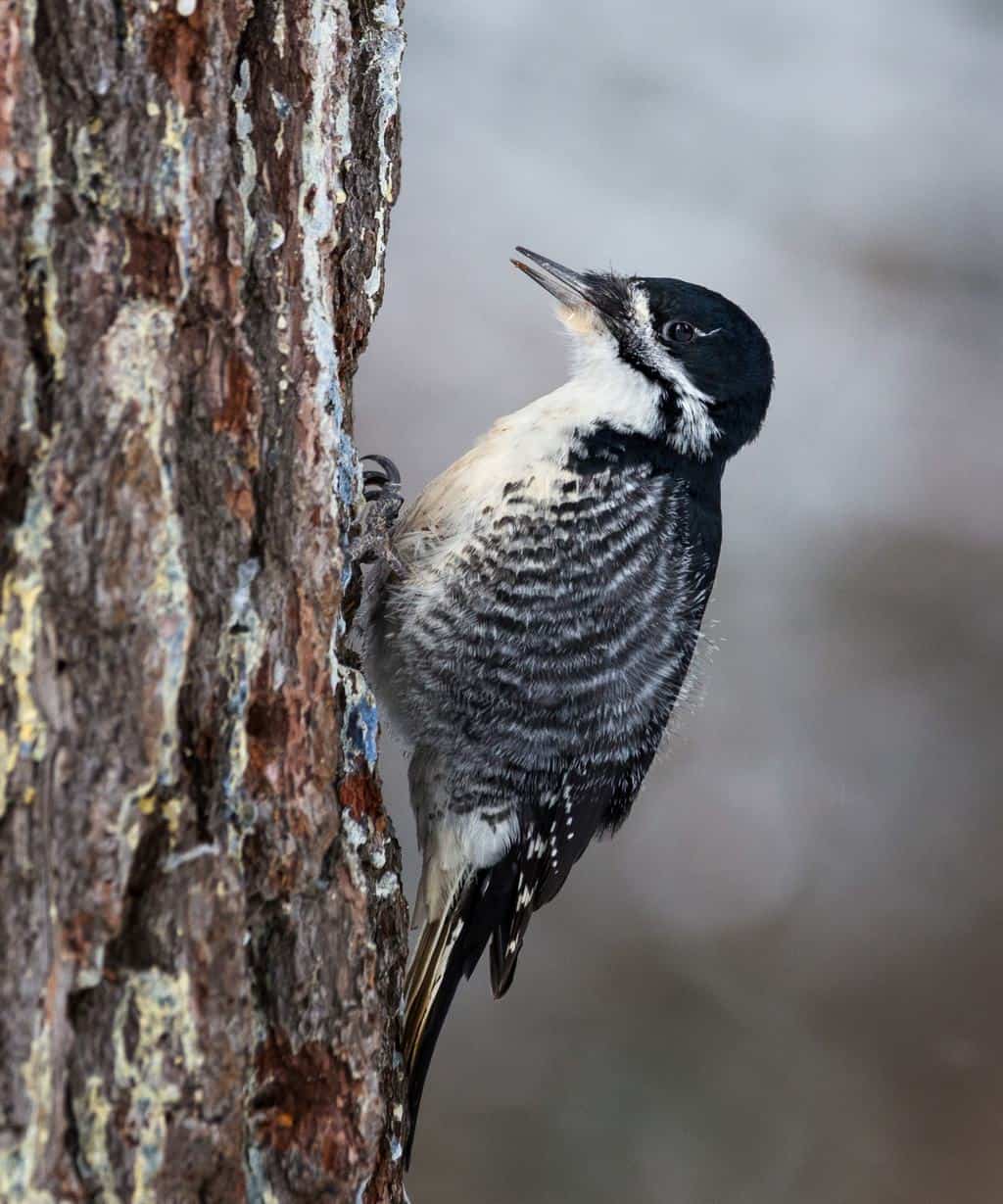
- Scientific Name: Picoides arcticus
- Length: 22 to 24 cm
- Weight: 2 to 3 oz
- Wingspan: 40 to 42 cm
Black-Backed Woodpeckers, also known as Arctic three-toed woodpeckers, are inky black birds with a single, sharp white stripe on their face resembling a mustache, and a half-white belly. Male black-backed woodpeckers have a bright yellow patch on top of his head.
You’ll often find these woodpeckers in forests that are just recently burned, foraging on charred, blackish tree trunks where they live off of insects over the next five to eight years. They may also drill on bark beetle outbreaks or bogs.
Compared to most woodpeckers, black-backed woodpeckers can spend long periods of time on a single spot. They thoroughly excavate trees to reach large wood-boring beetle larvae that are oftentimes burrowed deep inside the barks.
It’s difficult to attract black-backed woodpeckers because they mostly reside in dead, burnt trees and logs. However, they might be drawn to the sound of audible chewings of wood-boring insects in recent burns.
Northern Flicker
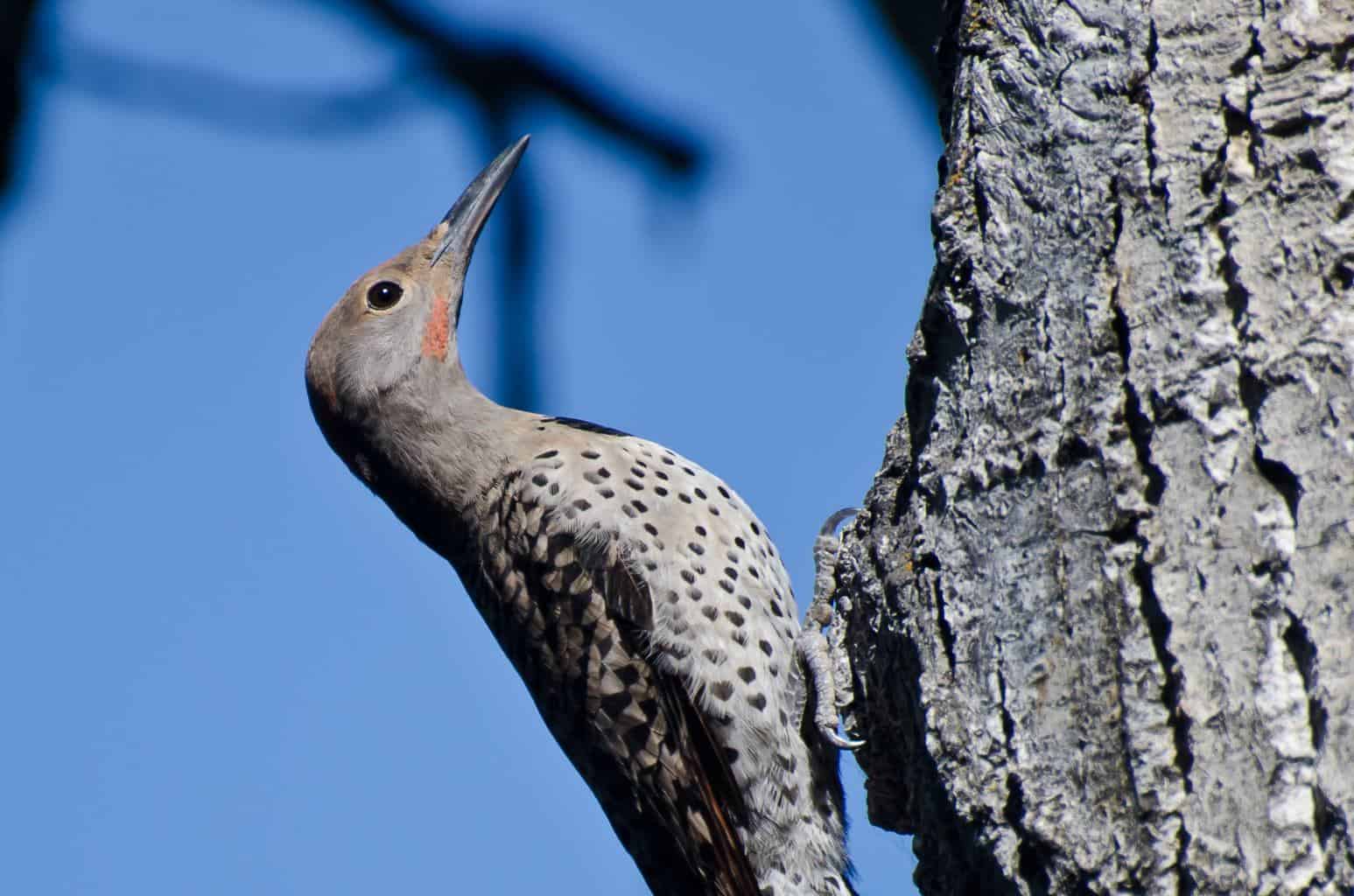
- Scientific Name: Colaptes auratus
- Length: 30 to 35 cm
- Weight: 4 oz
- Wingspan: 1 cm
Northern Flickers are fairly large, about half again as big as hairy woodpeckers. These glamorous birds are largely brown in color, with spots of black, white, yellow, and red, depending on the subspecies.
These woodpeckers spend most of their time on the ground, digging for ants and beetles with their unusually curved beaks. Some of the other invertebrates they feast on include flies, butterflies, moths, and snails.
When in trees, they’re often perched upright horizontal branches instead of leaning against their tails on a trunk. They like foraging alongside sparrows and blackbirds, and would sometimes eat berries and seeds if insects are nowhere to be found.
Like any other woodpeckers, northern flickers are found in woodlands, edges, yards, and city parks. You can also find them in wet areas such as streamside woods, flooded swamps, and marsh edges.
American Three-Toed Woodpecker

- Scientific Name: Picoides dorsalis
- Length: 21 cm
- Weight: 2 oz
- Wingspan: 38 cm
These small, unobtrusive woodpeckers linger in bark beetle outbreaks, young burned areas, and other disturbances where insect populations are plentiful.
Unlike typical woodpeckers, American three-toads would often chip sideways at dead and dying trees until flakes of bark fall away, as opposed to repeatedly drilling the surface with their beaks.
Mostly black and white in color, with males donning a yellow crown, these woodpeckers closely resemble black-backed woodpeckers, both in appearance and personality.
What makes this woodpecker so special, however, is the fact that they only have three toes as opposed to four like other woodpeckers.
This trait allows American three-toed woodpeckers to lean farther away from the tree, thereby hitting them harder than other species. For such a small bird, they sure are powerful!
Wrapping Up
Plenty of woodpecker species migrate to Maine because of its humid, continental climate. Woodpeckers play a vital role in helping to control insect pests, which is why many homeowners welcome them into their backyards.
If you’re looking to know more about birds, check out our list of the top 5 species of blackbirds found in Texas!











